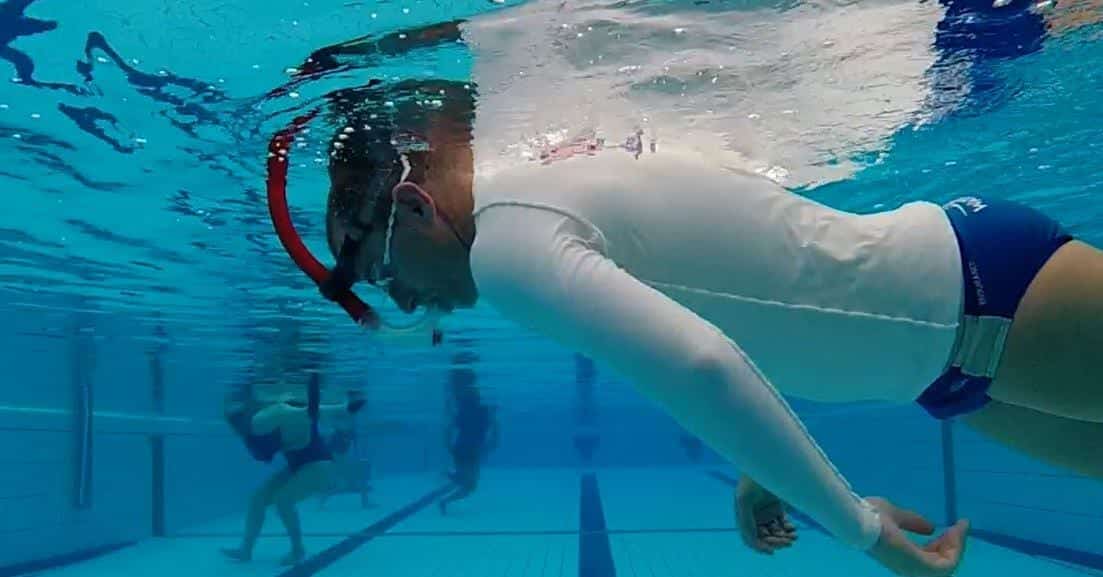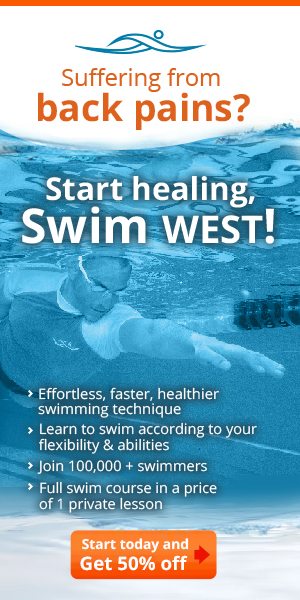We will focus on 2 aspects: the hydrotherapeutic aspect of back and neck treatment, and the swimming technique improving aspect.
Many swimmers who suffer neck or lower back problems can take care of the aching pain by individualized modified swimming technique.
Backstroke swimming
Backstroke is the only stroke in which the neck remains neutral. Releasing tension from the neck, as well as strengthening supporting muscles are possible by keeping the neck loose and having the arm entering the water smoothly. Lots of swimmers who suffer neck problems get dizzy while swimming backstroke. It is due a very sore neck, and they seem to have hard time loosening their body while swimming. Those are the type of people we recommend putting a snorkel on, so it is easier to maintain their head in a steady stream line with their body natural anatomical position , with no excessive head extension or deflection. Moreover, it is highly recommended to stretch out your arm and rotate your body without having your shoulder touching the check. In other words- don’t go for a maximum stretch with our arm, go for a semi- maximum one.
Over time, swimming with a snorkel improves symmetry, stream line, body rotation, and strengthens neck and supporting (shoulder, scapula, trapezius and rotator cuff) muscles. Breathing improves tremendously (because the snorkel makes your work harder to inhale air, due the dead space the snorkel creates along the tube).
Later on, you can try swimming freestyle with fins, breathing every 5 strokes, and keeping your chin in a continuous position with the sternum (the midline chest bone). Make sure your neck is fixed, and your body keeps rotating. Another drill you may find helpful releasing neck and shoulder tension is easy body rotation, wearing fins and snorkel. The water touches only one body part at a time (alternating shoulder, anterior and posterior delta muscles). It creates a unique water flow which loosens up your shoulders without manipulating body natural rhythm. You can try this drill without the snorkel; just make sure you take a deep breath (to avoid neck movement). Use the breaks on the walls for right breathing and stretching your shoulders and neck.
We recommend beginners swimming with no breathing, even if they don’t have neck problems, and combine breathing only later on, as they master technique skills. The reason is the complexity of integrating technique and breathing.
Swimmers around the world, of all levels, train with a snorkel, in order to improve swimming factors- hypoxia (swimming with no oxygen), stream line, symmetry, speed ect. Immature swimmers, as well as triathlon, or any swimmers who breath every 2 strokes can benefit greatly from drilling with a snorkel, by supporting the arm they lean on while breathing. It is inevitable that the opposing arm drags down, and doesn’t start pulling at the optimal height- close to water surface (basically it means the arm starts pulling too deep). Sometimes the head can sink in after breathing, which reflects on our entire body and uses up lots of our energy, in a continuous effort to compensate for it (such as trying to keep stream line, instead of moving forward).
Another problem mentioned before is breaking the stream line. Breathing every 2 strokes might cause irregular rhythm, and lots of up and down movement of the head on the vertical axis. This is where the snorkel comes handy- it helps us swimming symmetrically, loosely and in a stream line, so we can breathe better.
We are here to guide and coach you. Please contact us with any question you might have. So go ahead and try those swim WEST drills for yourselves, and make sure to keep us updated!
Swim WEST treats and heals thousands of people all around the globe for lower back, shoulder pain & neck pain, sometimes a little change in you swimming can make a huge change in life.



